An Analysis of Speight's and Heineken: International Management Report
VerifiedAdded on 2022/12/01
|22
|5999
|105
Report
AI Summary
This report provides a comprehensive analysis of the international management strategies employed by Speight's, a New Zealand brewery, and Heineken, a Dutch brewing company. It delves into their market entry strategies, including Greenfield investment and exporting, and examines their internationalization motives, resource allocation, and organizational structures. The report utilizes Porter's Diamond model and PESTLE analysis to assess the competitive advantages and external environments of both companies. Furthermore, it explores their supply chain management practices, corporate social responsibility activities, competitive advantages, and organizational cultures. The analysis highlights key aspects of their global operations, offering insights into their successes and challenges in the international market. The report concludes with a comparative assessment of the two companies, summarizing their key strategies and performance drivers.
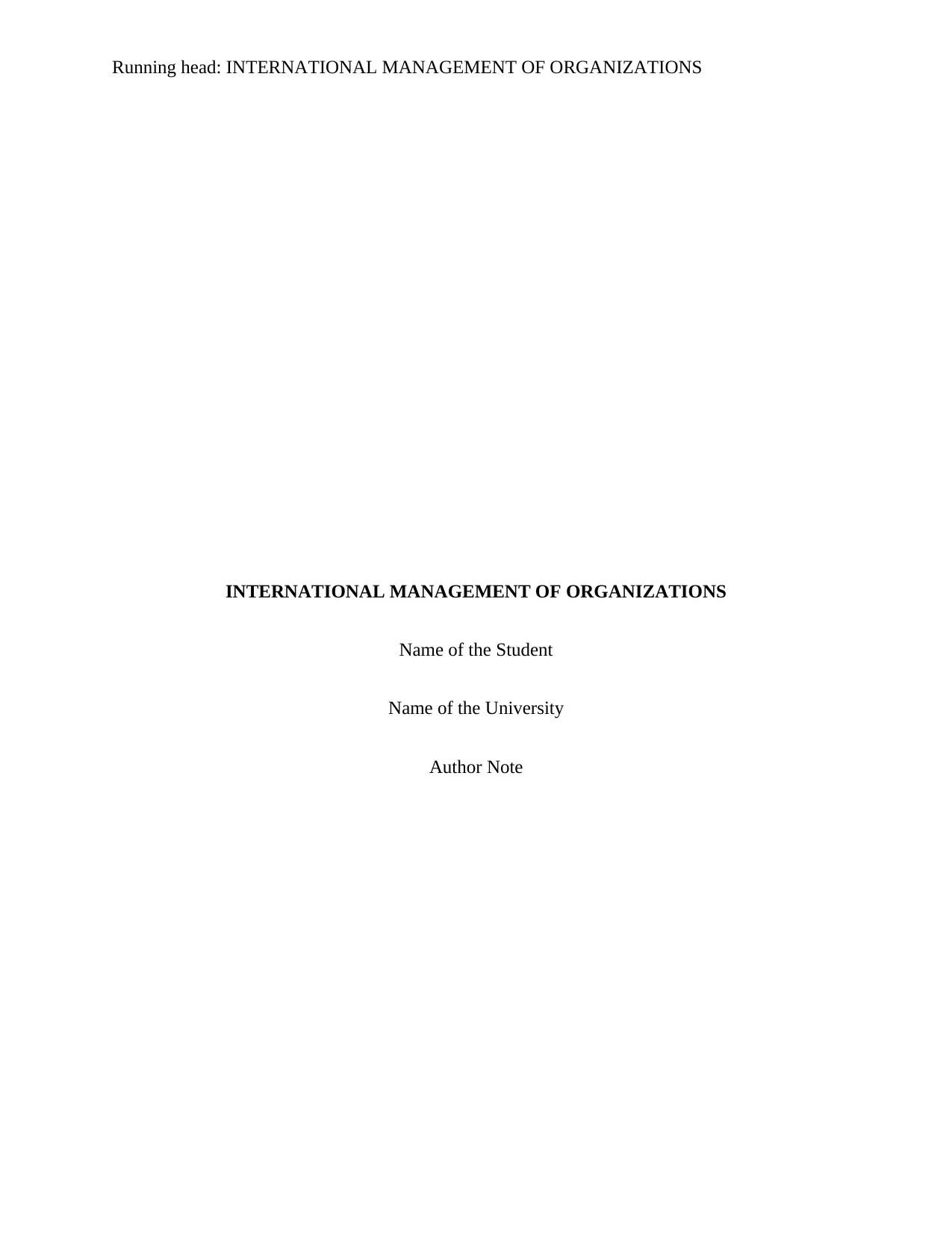
Running head: INTERNATIONAL MANAGEMENT OF ORGANIZATIONS
INTERNATIONAL MANAGEMENT OF ORGANIZATIONS
Name of the Student
Name of the University
Author Note
INTERNATIONAL MANAGEMENT OF ORGANIZATIONS
Name of the Student
Name of the University
Author Note
Paraphrase This Document
Need a fresh take? Get an instant paraphrase of this document with our AI Paraphraser
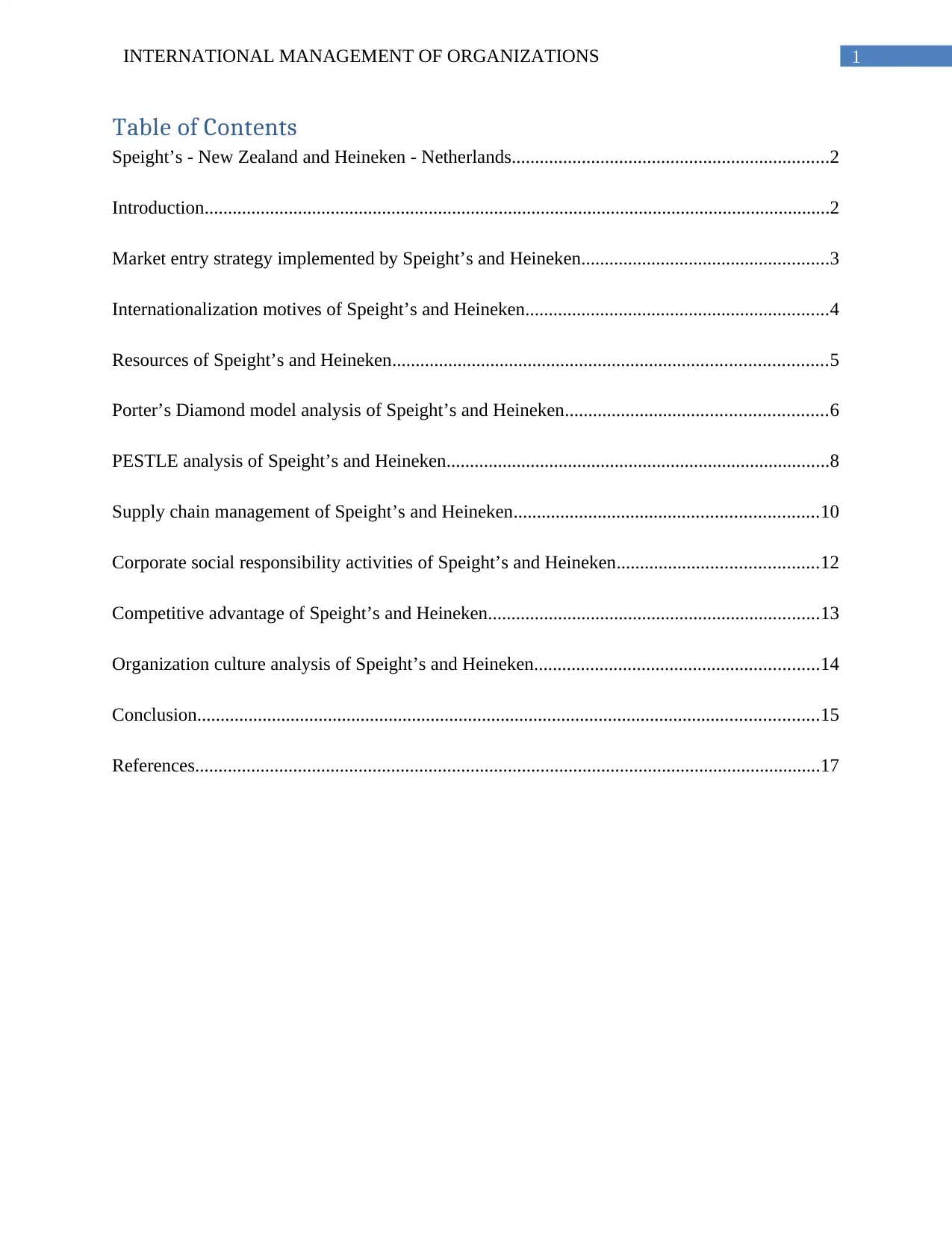
1INTERNATIONAL MANAGEMENT OF ORGANIZATIONS
Table of Contents
Speight’s - New Zealand and Heineken - Netherlands....................................................................2
Introduction......................................................................................................................................2
Market entry strategy implemented by Speight’s and Heineken.....................................................3
Internationalization motives of Speight’s and Heineken.................................................................4
Resources of Speight’s and Heineken.............................................................................................5
Porter’s Diamond model analysis of Speight’s and Heineken........................................................6
PESTLE analysis of Speight’s and Heineken..................................................................................8
Supply chain management of Speight’s and Heineken.................................................................10
Corporate social responsibility activities of Speight’s and Heineken...........................................12
Competitive advantage of Speight’s and Heineken.......................................................................13
Organization culture analysis of Speight’s and Heineken.............................................................14
Conclusion.....................................................................................................................................15
References......................................................................................................................................17
Table of Contents
Speight’s - New Zealand and Heineken - Netherlands....................................................................2
Introduction......................................................................................................................................2
Market entry strategy implemented by Speight’s and Heineken.....................................................3
Internationalization motives of Speight’s and Heineken.................................................................4
Resources of Speight’s and Heineken.............................................................................................5
Porter’s Diamond model analysis of Speight’s and Heineken........................................................6
PESTLE analysis of Speight’s and Heineken..................................................................................8
Supply chain management of Speight’s and Heineken.................................................................10
Corporate social responsibility activities of Speight’s and Heineken...........................................12
Competitive advantage of Speight’s and Heineken.......................................................................13
Organization culture analysis of Speight’s and Heineken.............................................................14
Conclusion.....................................................................................................................................15
References......................................................................................................................................17
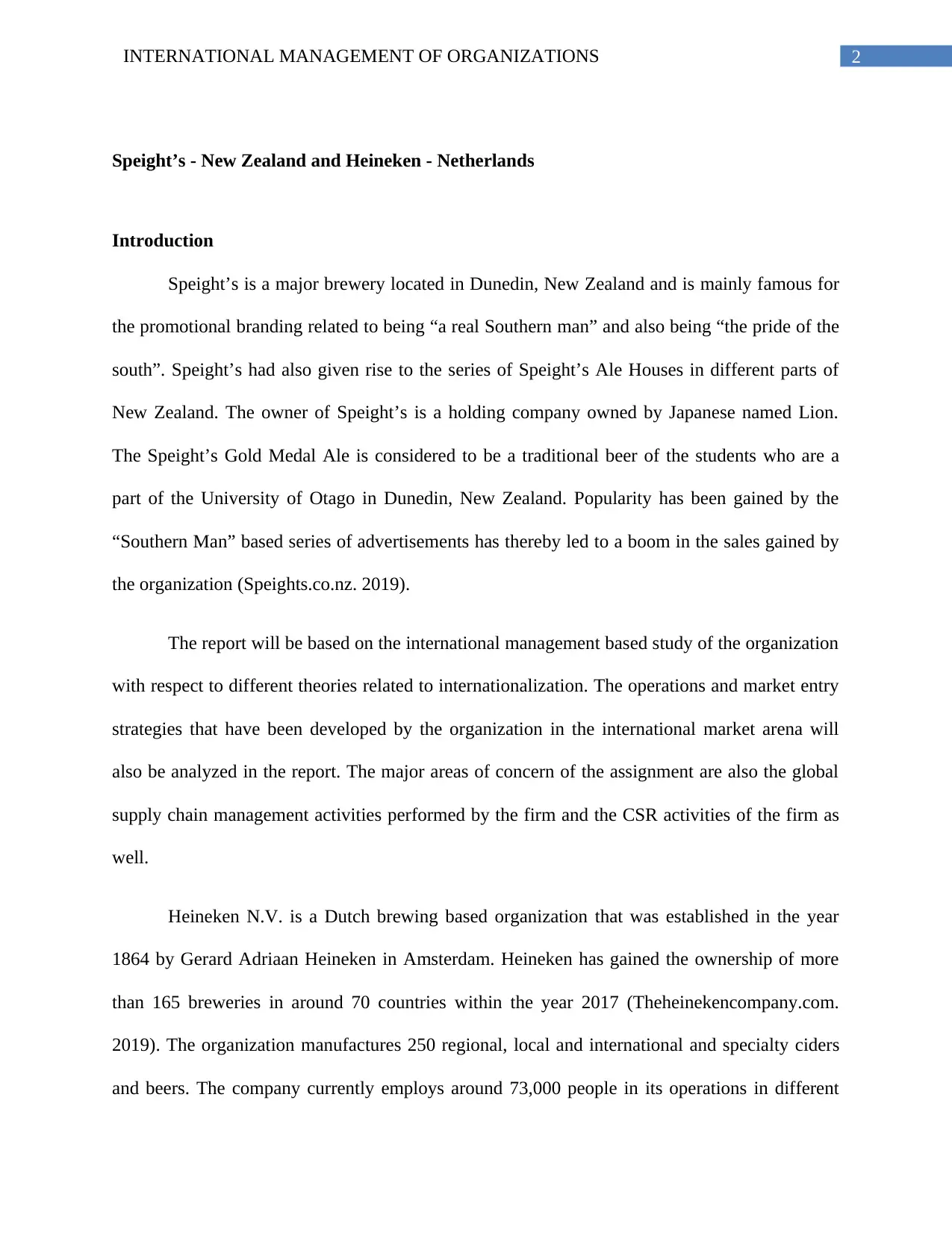
2INTERNATIONAL MANAGEMENT OF ORGANIZATIONS
Speight’s - New Zealand and Heineken - Netherlands
Introduction
Speight’s is a major brewery located in Dunedin, New Zealand and is mainly famous for
the promotional branding related to being “a real Southern man” and also being “the pride of the
south”. Speight’s had also given rise to the series of Speight’s Ale Houses in different parts of
New Zealand. The owner of Speight’s is a holding company owned by Japanese named Lion.
The Speight’s Gold Medal Ale is considered to be a traditional beer of the students who are a
part of the University of Otago in Dunedin, New Zealand. Popularity has been gained by the
“Southern Man” based series of advertisements has thereby led to a boom in the sales gained by
the organization (Speights.co.nz. 2019).
The report will be based on the international management based study of the organization
with respect to different theories related to internationalization. The operations and market entry
strategies that have been developed by the organization in the international market arena will
also be analyzed in the report. The major areas of concern of the assignment are also the global
supply chain management activities performed by the firm and the CSR activities of the firm as
well.
Heineken N.V. is a Dutch brewing based organization that was established in the year
1864 by Gerard Adriaan Heineken in Amsterdam. Heineken has gained the ownership of more
than 165 breweries in around 70 countries within the year 2017 (Theheinekencompany.com.
2019). The organization manufactures 250 regional, local and international and specialty ciders
and beers. The company currently employs around 73,000 people in its operations in different
Speight’s - New Zealand and Heineken - Netherlands
Introduction
Speight’s is a major brewery located in Dunedin, New Zealand and is mainly famous for
the promotional branding related to being “a real Southern man” and also being “the pride of the
south”. Speight’s had also given rise to the series of Speight’s Ale Houses in different parts of
New Zealand. The owner of Speight’s is a holding company owned by Japanese named Lion.
The Speight’s Gold Medal Ale is considered to be a traditional beer of the students who are a
part of the University of Otago in Dunedin, New Zealand. Popularity has been gained by the
“Southern Man” based series of advertisements has thereby led to a boom in the sales gained by
the organization (Speights.co.nz. 2019).
The report will be based on the international management based study of the organization
with respect to different theories related to internationalization. The operations and market entry
strategies that have been developed by the organization in the international market arena will
also be analyzed in the report. The major areas of concern of the assignment are also the global
supply chain management activities performed by the firm and the CSR activities of the firm as
well.
Heineken N.V. is a Dutch brewing based organization that was established in the year
1864 by Gerard Adriaan Heineken in Amsterdam. Heineken has gained the ownership of more
than 165 breweries in around 70 countries within the year 2017 (Theheinekencompany.com.
2019). The organization manufactures 250 regional, local and international and specialty ciders
and beers. The company currently employs around 73,000 people in its operations in different
⊘ This is a preview!⊘
Do you want full access?
Subscribe today to unlock all pages.

Trusted by 1+ million students worldwide
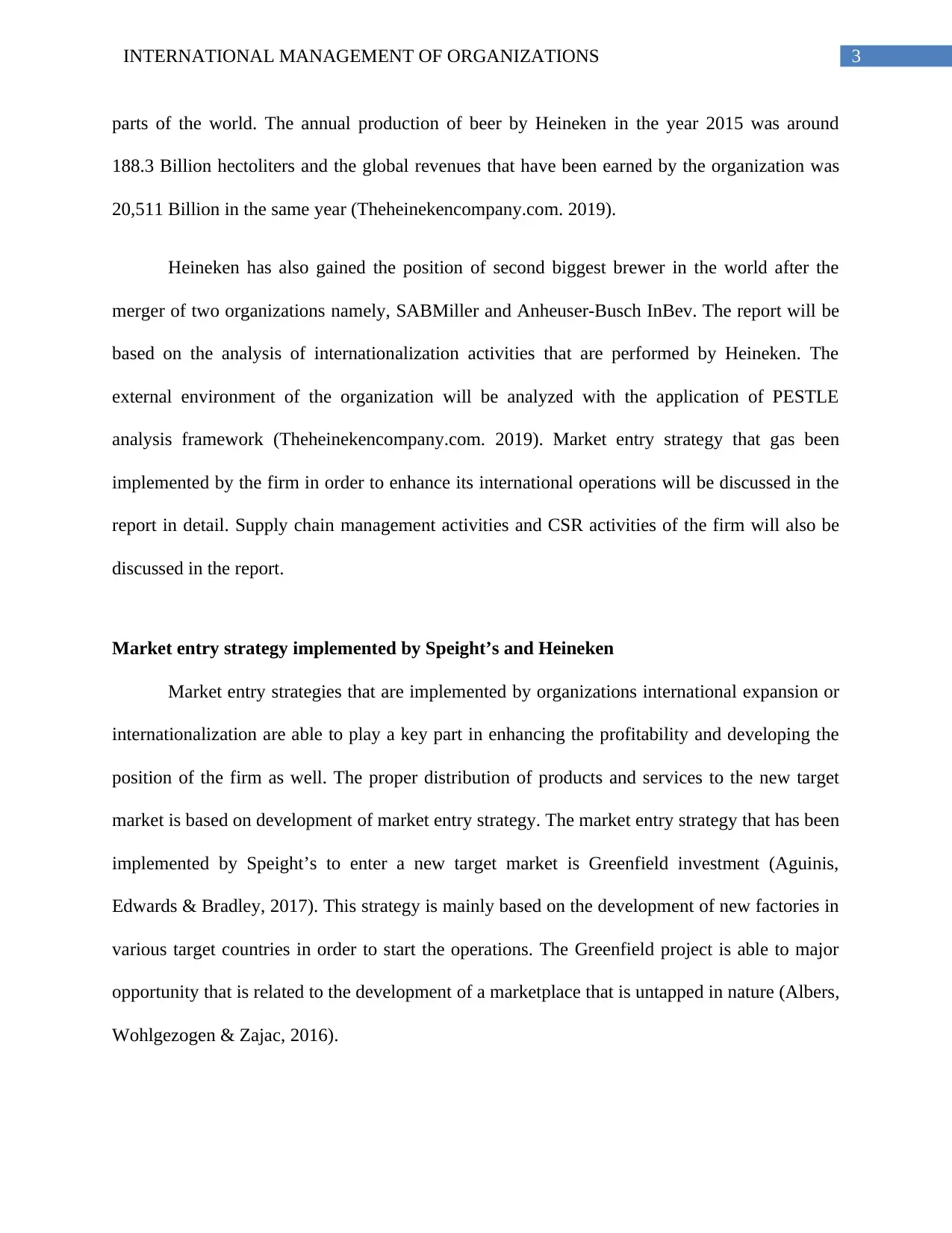
3INTERNATIONAL MANAGEMENT OF ORGANIZATIONS
parts of the world. The annual production of beer by Heineken in the year 2015 was around
188.3 Billion hectoliters and the global revenues that have been earned by the organization was
20,511 Billion in the same year (Theheinekencompany.com. 2019).
Heineken has also gained the position of second biggest brewer in the world after the
merger of two organizations namely, SABMiller and Anheuser-Busch InBev. The report will be
based on the analysis of internationalization activities that are performed by Heineken. The
external environment of the organization will be analyzed with the application of PESTLE
analysis framework (Theheinekencompany.com. 2019). Market entry strategy that gas been
implemented by the firm in order to enhance its international operations will be discussed in the
report in detail. Supply chain management activities and CSR activities of the firm will also be
discussed in the report.
Market entry strategy implemented by Speight’s and Heineken
Market entry strategies that are implemented by organizations international expansion or
internationalization are able to play a key part in enhancing the profitability and developing the
position of the firm as well. The proper distribution of products and services to the new target
market is based on development of market entry strategy. The market entry strategy that has been
implemented by Speight’s to enter a new target market is Greenfield investment (Aguinis,
Edwards & Bradley, 2017). This strategy is mainly based on the development of new factories in
various target countries in order to start the operations. The Greenfield project is able to major
opportunity that is related to the development of a marketplace that is untapped in nature (Albers,
Wohlgezogen & Zajac, 2016).
parts of the world. The annual production of beer by Heineken in the year 2015 was around
188.3 Billion hectoliters and the global revenues that have been earned by the organization was
20,511 Billion in the same year (Theheinekencompany.com. 2019).
Heineken has also gained the position of second biggest brewer in the world after the
merger of two organizations namely, SABMiller and Anheuser-Busch InBev. The report will be
based on the analysis of internationalization activities that are performed by Heineken. The
external environment of the organization will be analyzed with the application of PESTLE
analysis framework (Theheinekencompany.com. 2019). Market entry strategy that gas been
implemented by the firm in order to enhance its international operations will be discussed in the
report in detail. Supply chain management activities and CSR activities of the firm will also be
discussed in the report.
Market entry strategy implemented by Speight’s and Heineken
Market entry strategies that are implemented by organizations international expansion or
internationalization are able to play a key part in enhancing the profitability and developing the
position of the firm as well. The proper distribution of products and services to the new target
market is based on development of market entry strategy. The market entry strategy that has been
implemented by Speight’s to enter a new target market is Greenfield investment (Aguinis,
Edwards & Bradley, 2017). This strategy is mainly based on the development of new factories in
various target countries in order to start the operations. The Greenfield project is able to major
opportunity that is related to the development of a marketplace that is untapped in nature (Albers,
Wohlgezogen & Zajac, 2016).
Paraphrase This Document
Need a fresh take? Get an instant paraphrase of this document with our AI Paraphraser
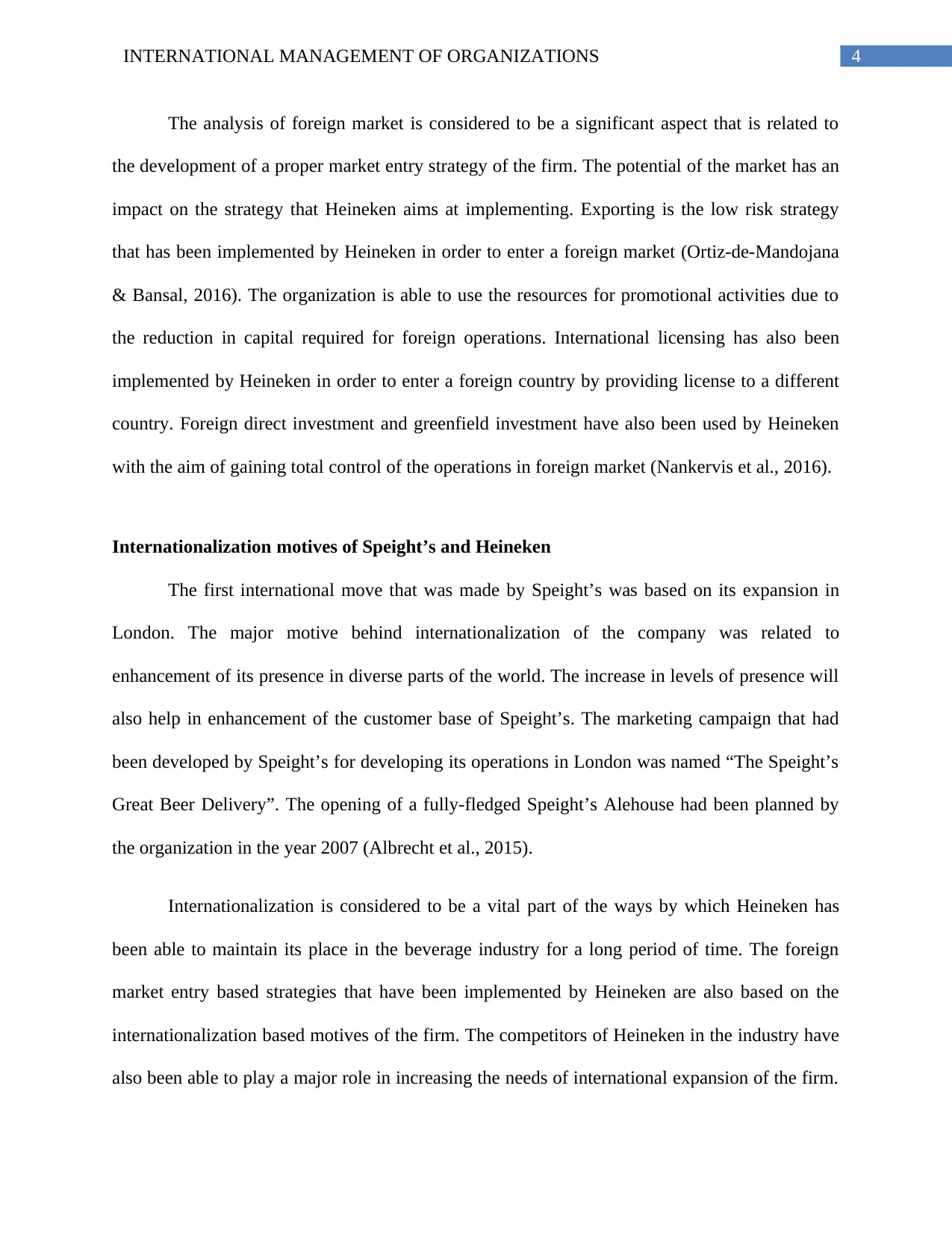
4INTERNATIONAL MANAGEMENT OF ORGANIZATIONS
The analysis of foreign market is considered to be a significant aspect that is related to
the development of a proper market entry strategy of the firm. The potential of the market has an
impact on the strategy that Heineken aims at implementing. Exporting is the low risk strategy
that has been implemented by Heineken in order to enter a foreign market (Ortiz‐de‐Mandojana
& Bansal, 2016). The organization is able to use the resources for promotional activities due to
the reduction in capital required for foreign operations. International licensing has also been
implemented by Heineken in order to enter a foreign country by providing license to a different
country. Foreign direct investment and greenfield investment have also been used by Heineken
with the aim of gaining total control of the operations in foreign market (Nankervis et al., 2016).
Internationalization motives of Speight’s and Heineken
The first international move that was made by Speight’s was based on its expansion in
London. The major motive behind internationalization of the company was related to
enhancement of its presence in diverse parts of the world. The increase in levels of presence will
also help in enhancement of the customer base of Speight’s. The marketing campaign that had
been developed by Speight’s for developing its operations in London was named “The Speight’s
Great Beer Delivery”. The opening of a fully-fledged Speight’s Alehouse had been planned by
the organization in the year 2007 (Albrecht et al., 2015).
Internationalization is considered to be a vital part of the ways by which Heineken has
been able to maintain its place in the beverage industry for a long period of time. The foreign
market entry based strategies that have been implemented by Heineken are also based on the
internationalization based motives of the firm. The competitors of Heineken in the industry have
also been able to play a major role in increasing the needs of international expansion of the firm.
The analysis of foreign market is considered to be a significant aspect that is related to
the development of a proper market entry strategy of the firm. The potential of the market has an
impact on the strategy that Heineken aims at implementing. Exporting is the low risk strategy
that has been implemented by Heineken in order to enter a foreign market (Ortiz‐de‐Mandojana
& Bansal, 2016). The organization is able to use the resources for promotional activities due to
the reduction in capital required for foreign operations. International licensing has also been
implemented by Heineken in order to enter a foreign country by providing license to a different
country. Foreign direct investment and greenfield investment have also been used by Heineken
with the aim of gaining total control of the operations in foreign market (Nankervis et al., 2016).
Internationalization motives of Speight’s and Heineken
The first international move that was made by Speight’s was based on its expansion in
London. The major motive behind internationalization of the company was related to
enhancement of its presence in diverse parts of the world. The increase in levels of presence will
also help in enhancement of the customer base of Speight’s. The marketing campaign that had
been developed by Speight’s for developing its operations in London was named “The Speight’s
Great Beer Delivery”. The opening of a fully-fledged Speight’s Alehouse had been planned by
the organization in the year 2007 (Albrecht et al., 2015).
Internationalization is considered to be a vital part of the ways by which Heineken has
been able to maintain its place in the beverage industry for a long period of time. The foreign
market entry based strategies that have been implemented by Heineken are also based on the
internationalization based motives of the firm. The competitors of Heineken in the industry have
also been able to play a major role in increasing the needs of international expansion of the firm.
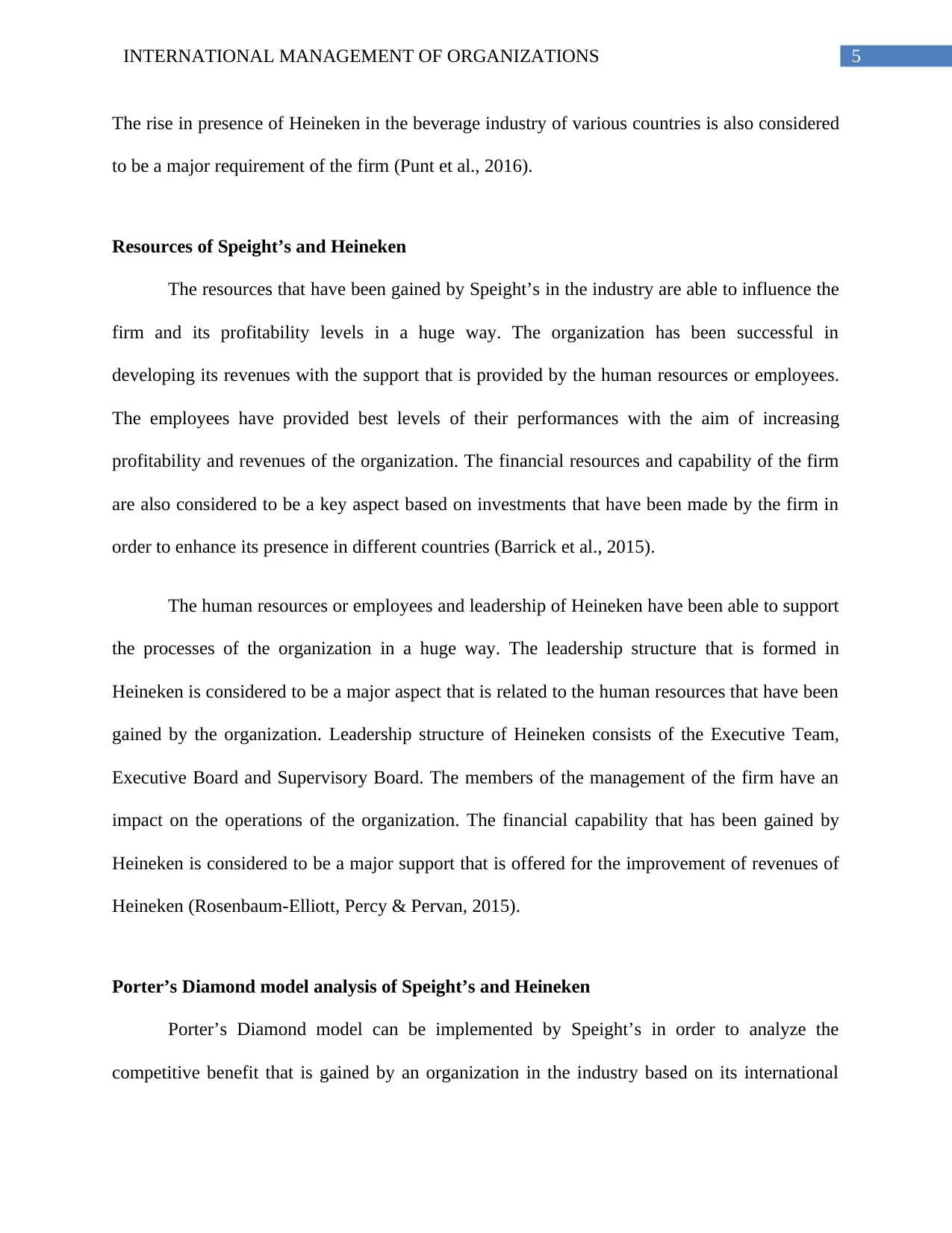
5INTERNATIONAL MANAGEMENT OF ORGANIZATIONS
The rise in presence of Heineken in the beverage industry of various countries is also considered
to be a major requirement of the firm (Punt et al., 2016).
Resources of Speight’s and Heineken
The resources that have been gained by Speight’s in the industry are able to influence the
firm and its profitability levels in a huge way. The organization has been successful in
developing its revenues with the support that is provided by the human resources or employees.
The employees have provided best levels of their performances with the aim of increasing
profitability and revenues of the organization. The financial resources and capability of the firm
are also considered to be a key aspect based on investments that have been made by the firm in
order to enhance its presence in different countries (Barrick et al., 2015).
The human resources or employees and leadership of Heineken have been able to support
the processes of the organization in a huge way. The leadership structure that is formed in
Heineken is considered to be a major aspect that is related to the human resources that have been
gained by the organization. Leadership structure of Heineken consists of the Executive Team,
Executive Board and Supervisory Board. The members of the management of the firm have an
impact on the operations of the organization. The financial capability that has been gained by
Heineken is considered to be a major support that is offered for the improvement of revenues of
Heineken (Rosenbaum-Elliott, Percy & Pervan, 2015).
Porter’s Diamond model analysis of Speight’s and Heineken
Porter’s Diamond model can be implemented by Speight’s in order to analyze the
competitive benefit that is gained by an organization in the industry based on its international
The rise in presence of Heineken in the beverage industry of various countries is also considered
to be a major requirement of the firm (Punt et al., 2016).
Resources of Speight’s and Heineken
The resources that have been gained by Speight’s in the industry are able to influence the
firm and its profitability levels in a huge way. The organization has been successful in
developing its revenues with the support that is provided by the human resources or employees.
The employees have provided best levels of their performances with the aim of increasing
profitability and revenues of the organization. The financial resources and capability of the firm
are also considered to be a key aspect based on investments that have been made by the firm in
order to enhance its presence in different countries (Barrick et al., 2015).
The human resources or employees and leadership of Heineken have been able to support
the processes of the organization in a huge way. The leadership structure that is formed in
Heineken is considered to be a major aspect that is related to the human resources that have been
gained by the organization. Leadership structure of Heineken consists of the Executive Team,
Executive Board and Supervisory Board. The members of the management of the firm have an
impact on the operations of the organization. The financial capability that has been gained by
Heineken is considered to be a major support that is offered for the improvement of revenues of
Heineken (Rosenbaum-Elliott, Percy & Pervan, 2015).
Porter’s Diamond model analysis of Speight’s and Heineken
Porter’s Diamond model can be implemented by Speight’s in order to analyze the
competitive benefit that is gained by an organization in the industry based on its international
⊘ This is a preview!⊘
Do you want full access?
Subscribe today to unlock all pages.

Trusted by 1+ million students worldwide
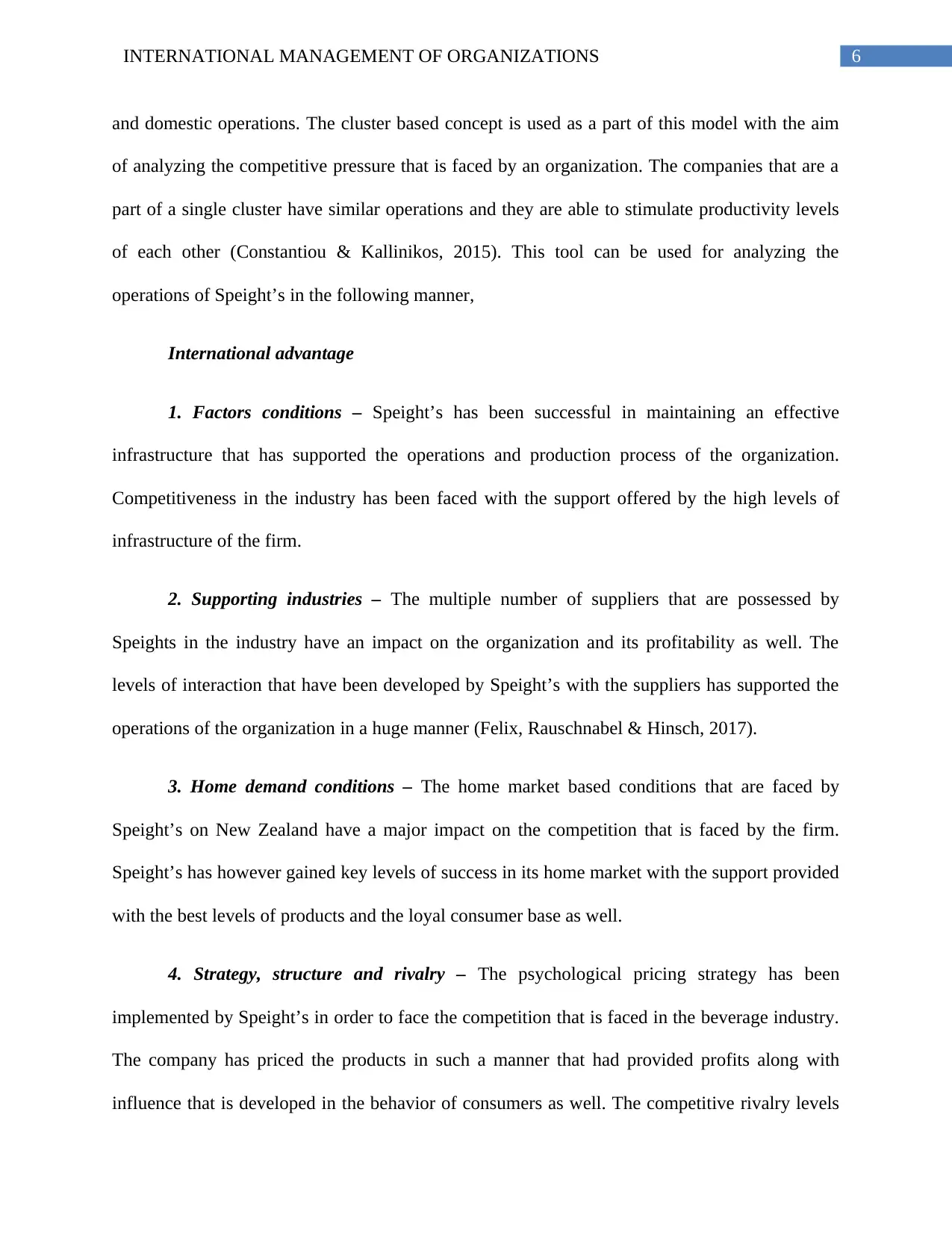
6INTERNATIONAL MANAGEMENT OF ORGANIZATIONS
and domestic operations. The cluster based concept is used as a part of this model with the aim
of analyzing the competitive pressure that is faced by an organization. The companies that are a
part of a single cluster have similar operations and they are able to stimulate productivity levels
of each other (Constantiou & Kallinikos, 2015). This tool can be used for analyzing the
operations of Speight’s in the following manner,
International advantage
1. Factors conditions – Speight’s has been successful in maintaining an effective
infrastructure that has supported the operations and production process of the organization.
Competitiveness in the industry has been faced with the support offered by the high levels of
infrastructure of the firm.
2. Supporting industries – The multiple number of suppliers that are possessed by
Speights in the industry have an impact on the organization and its profitability as well. The
levels of interaction that have been developed by Speight’s with the suppliers has supported the
operations of the organization in a huge manner (Felix, Rauschnabel & Hinsch, 2017).
3. Home demand conditions – The home market based conditions that are faced by
Speight’s on New Zealand have a major impact on the competition that is faced by the firm.
Speight’s has however gained key levels of success in its home market with the support provided
with the best levels of products and the loyal consumer base as well.
4. Strategy, structure and rivalry – The psychological pricing strategy has been
implemented by Speight’s in order to face the competition that is faced in the beverage industry.
The company has priced the products in such a manner that had provided profits along with
influence that is developed in the behavior of consumers as well. The competitive rivalry levels
and domestic operations. The cluster based concept is used as a part of this model with the aim
of analyzing the competitive pressure that is faced by an organization. The companies that are a
part of a single cluster have similar operations and they are able to stimulate productivity levels
of each other (Constantiou & Kallinikos, 2015). This tool can be used for analyzing the
operations of Speight’s in the following manner,
International advantage
1. Factors conditions – Speight’s has been successful in maintaining an effective
infrastructure that has supported the operations and production process of the organization.
Competitiveness in the industry has been faced with the support offered by the high levels of
infrastructure of the firm.
2. Supporting industries – The multiple number of suppliers that are possessed by
Speights in the industry have an impact on the organization and its profitability as well. The
levels of interaction that have been developed by Speight’s with the suppliers has supported the
operations of the organization in a huge manner (Felix, Rauschnabel & Hinsch, 2017).
3. Home demand conditions – The home market based conditions that are faced by
Speight’s on New Zealand have a major impact on the competition that is faced by the firm.
Speight’s has however gained key levels of success in its home market with the support provided
with the best levels of products and the loyal consumer base as well.
4. Strategy, structure and rivalry – The psychological pricing strategy has been
implemented by Speight’s in order to face the competition that is faced in the beverage industry.
The company has priced the products in such a manner that had provided profits along with
influence that is developed in the behavior of consumers as well. The competitive rivalry levels
Paraphrase This Document
Need a fresh take? Get an instant paraphrase of this document with our AI Paraphraser
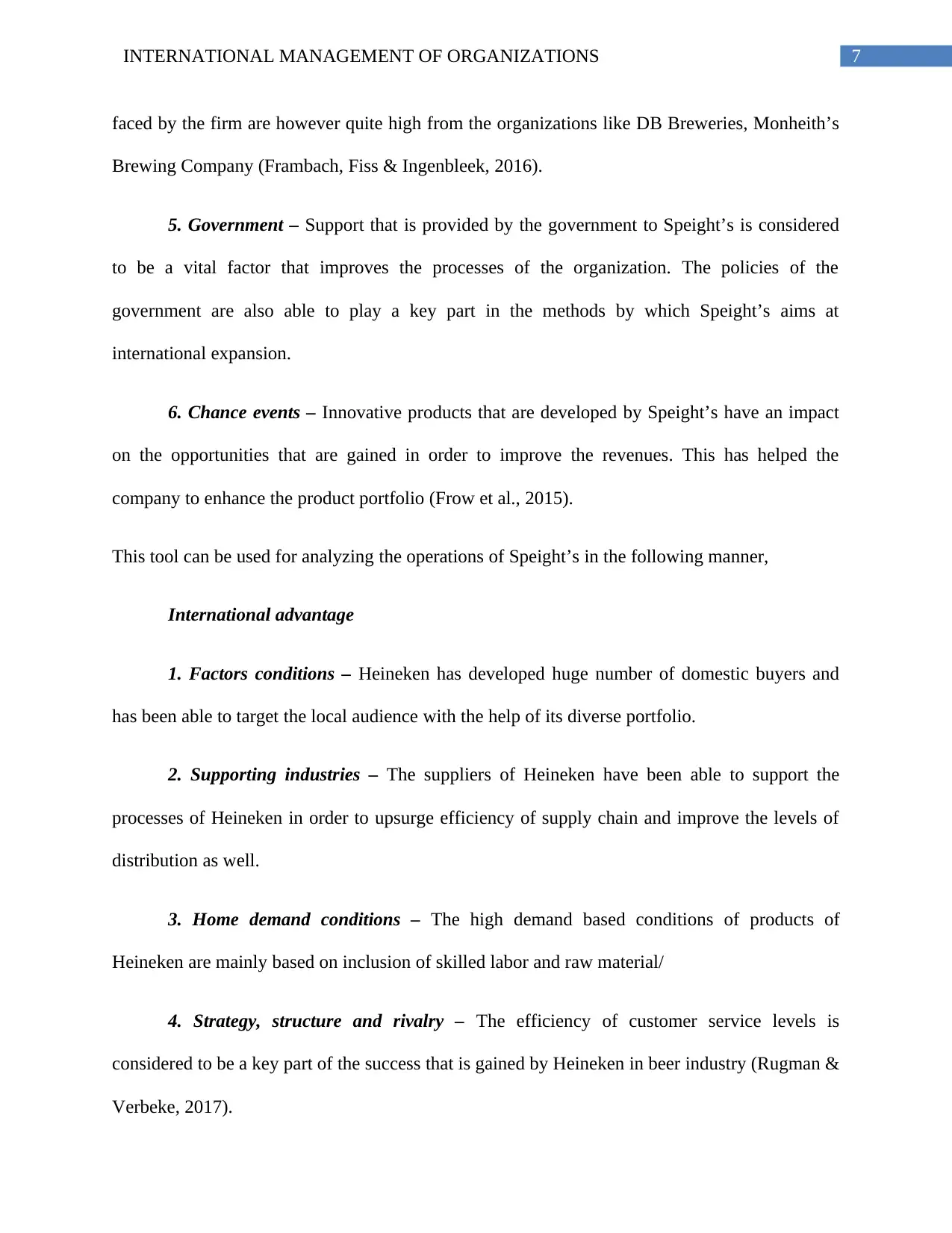
7INTERNATIONAL MANAGEMENT OF ORGANIZATIONS
faced by the firm are however quite high from the organizations like DB Breweries, Monheith’s
Brewing Company (Frambach, Fiss & Ingenbleek, 2016).
5. Government – Support that is provided by the government to Speight’s is considered
to be a vital factor that improves the processes of the organization. The policies of the
government are also able to play a key part in the methods by which Speight’s aims at
international expansion.
6. Chance events – Innovative products that are developed by Speight’s have an impact
on the opportunities that are gained in order to improve the revenues. This has helped the
company to enhance the product portfolio (Frow et al., 2015).
This tool can be used for analyzing the operations of Speight’s in the following manner,
International advantage
1. Factors conditions – Heineken has developed huge number of domestic buyers and
has been able to target the local audience with the help of its diverse portfolio.
2. Supporting industries – The suppliers of Heineken have been able to support the
processes of Heineken in order to upsurge efficiency of supply chain and improve the levels of
distribution as well.
3. Home demand conditions – The high demand based conditions of products of
Heineken are mainly based on inclusion of skilled labor and raw material/
4. Strategy, structure and rivalry – The efficiency of customer service levels is
considered to be a key part of the success that is gained by Heineken in beer industry (Rugman &
Verbeke, 2017).
faced by the firm are however quite high from the organizations like DB Breweries, Monheith’s
Brewing Company (Frambach, Fiss & Ingenbleek, 2016).
5. Government – Support that is provided by the government to Speight’s is considered
to be a vital factor that improves the processes of the organization. The policies of the
government are also able to play a key part in the methods by which Speight’s aims at
international expansion.
6. Chance events – Innovative products that are developed by Speight’s have an impact
on the opportunities that are gained in order to improve the revenues. This has helped the
company to enhance the product portfolio (Frow et al., 2015).
This tool can be used for analyzing the operations of Speight’s in the following manner,
International advantage
1. Factors conditions – Heineken has developed huge number of domestic buyers and
has been able to target the local audience with the help of its diverse portfolio.
2. Supporting industries – The suppliers of Heineken have been able to support the
processes of Heineken in order to upsurge efficiency of supply chain and improve the levels of
distribution as well.
3. Home demand conditions – The high demand based conditions of products of
Heineken are mainly based on inclusion of skilled labor and raw material/
4. Strategy, structure and rivalry – The efficiency of customer service levels is
considered to be a key part of the success that is gained by Heineken in beer industry (Rugman &
Verbeke, 2017).
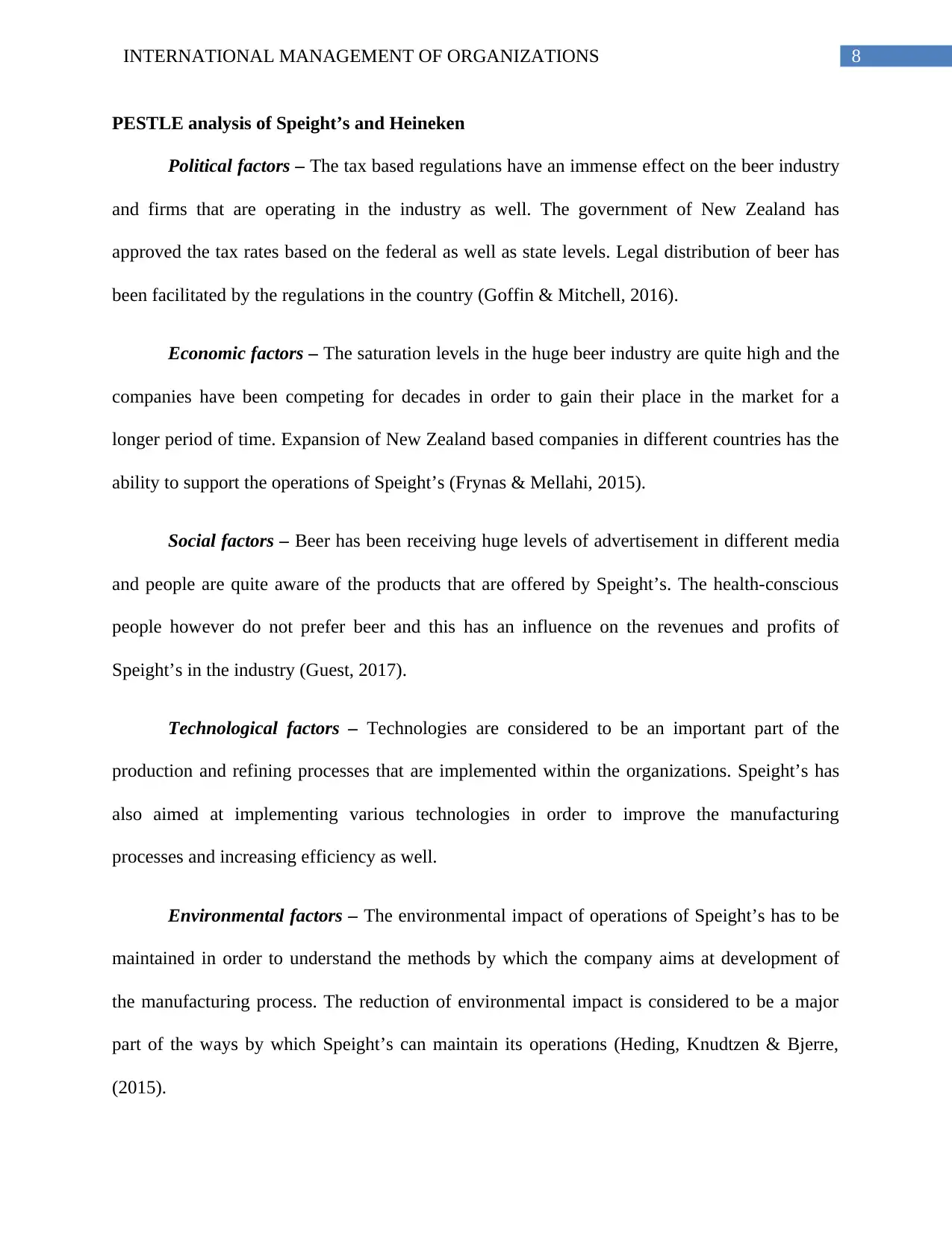
8INTERNATIONAL MANAGEMENT OF ORGANIZATIONS
PESTLE analysis of Speight’s and Heineken
Political factors – The tax based regulations have an immense effect on the beer industry
and firms that are operating in the industry as well. The government of New Zealand has
approved the tax rates based on the federal as well as state levels. Legal distribution of beer has
been facilitated by the regulations in the country (Goffin & Mitchell, 2016).
Economic factors – The saturation levels in the huge beer industry are quite high and the
companies have been competing for decades in order to gain their place in the market for a
longer period of time. Expansion of New Zealand based companies in different countries has the
ability to support the operations of Speight’s (Frynas & Mellahi, 2015).
Social factors – Beer has been receiving huge levels of advertisement in different media
and people are quite aware of the products that are offered by Speight’s. The health-conscious
people however do not prefer beer and this has an influence on the revenues and profits of
Speight’s in the industry (Guest, 2017).
Technological factors – Technologies are considered to be an important part of the
production and refining processes that are implemented within the organizations. Speight’s has
also aimed at implementing various technologies in order to improve the manufacturing
processes and increasing efficiency as well.
Environmental factors – The environmental impact of operations of Speight’s has to be
maintained in order to understand the methods by which the company aims at development of
the manufacturing process. The reduction of environmental impact is considered to be a major
part of the ways by which Speight’s can maintain its operations (Heding, Knudtzen & Bjerre,
(2015).
PESTLE analysis of Speight’s and Heineken
Political factors – The tax based regulations have an immense effect on the beer industry
and firms that are operating in the industry as well. The government of New Zealand has
approved the tax rates based on the federal as well as state levels. Legal distribution of beer has
been facilitated by the regulations in the country (Goffin & Mitchell, 2016).
Economic factors – The saturation levels in the huge beer industry are quite high and the
companies have been competing for decades in order to gain their place in the market for a
longer period of time. Expansion of New Zealand based companies in different countries has the
ability to support the operations of Speight’s (Frynas & Mellahi, 2015).
Social factors – Beer has been receiving huge levels of advertisement in different media
and people are quite aware of the products that are offered by Speight’s. The health-conscious
people however do not prefer beer and this has an influence on the revenues and profits of
Speight’s in the industry (Guest, 2017).
Technological factors – Technologies are considered to be an important part of the
production and refining processes that are implemented within the organizations. Speight’s has
also aimed at implementing various technologies in order to improve the manufacturing
processes and increasing efficiency as well.
Environmental factors – The environmental impact of operations of Speight’s has to be
maintained in order to understand the methods by which the company aims at development of
the manufacturing process. The reduction of environmental impact is considered to be a major
part of the ways by which Speight’s can maintain its operations (Heding, Knudtzen & Bjerre,
(2015).
⊘ This is a preview!⊘
Do you want full access?
Subscribe today to unlock all pages.

Trusted by 1+ million students worldwide
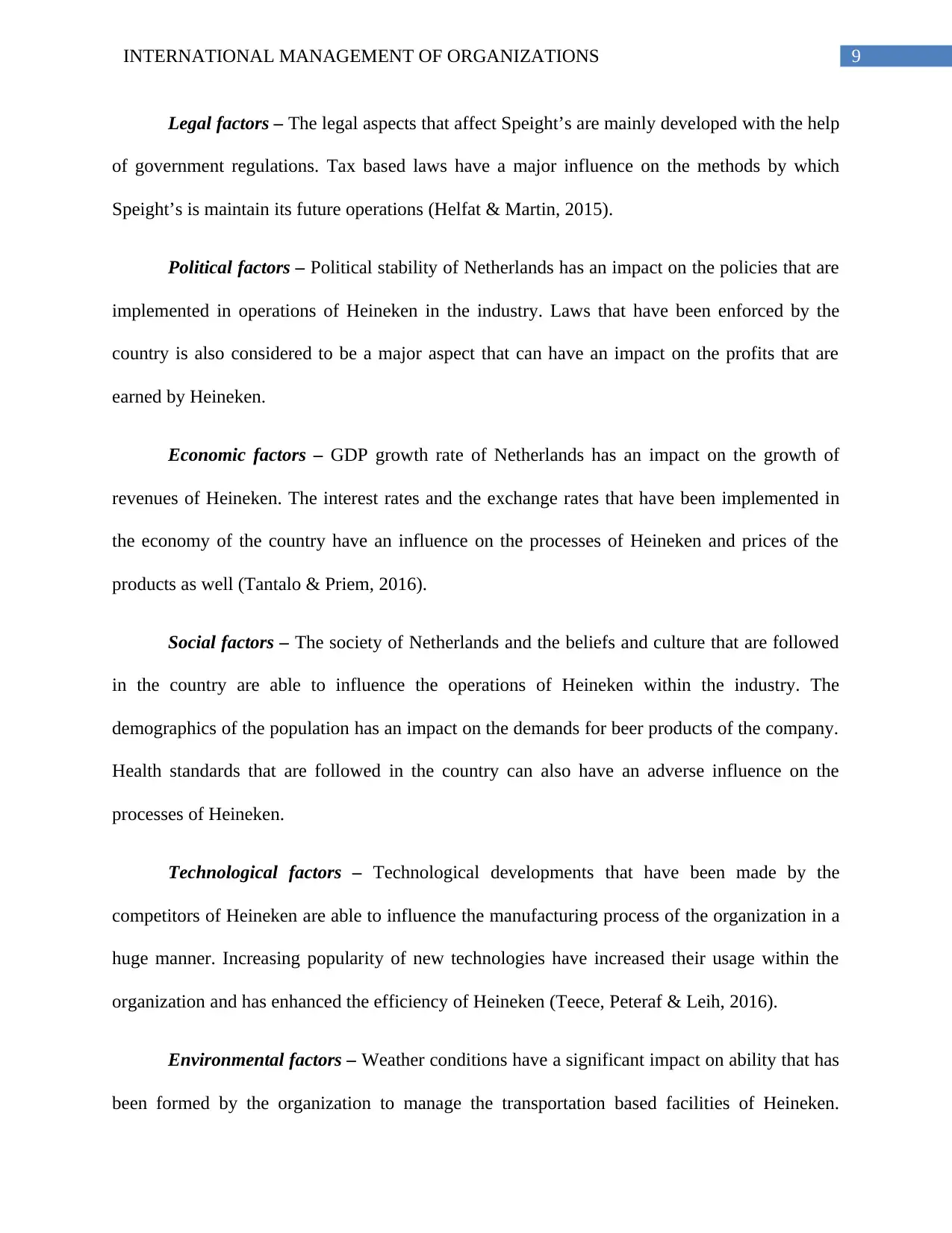
9INTERNATIONAL MANAGEMENT OF ORGANIZATIONS
Legal factors – The legal aspects that affect Speight’s are mainly developed with the help
of government regulations. Tax based laws have a major influence on the methods by which
Speight’s is maintain its future operations (Helfat & Martin, 2015).
Political factors – Political stability of Netherlands has an impact on the policies that are
implemented in operations of Heineken in the industry. Laws that have been enforced by the
country is also considered to be a major aspect that can have an impact on the profits that are
earned by Heineken.
Economic factors – GDP growth rate of Netherlands has an impact on the growth of
revenues of Heineken. The interest rates and the exchange rates that have been implemented in
the economy of the country have an influence on the processes of Heineken and prices of the
products as well (Tantalo & Priem, 2016).
Social factors – The society of Netherlands and the beliefs and culture that are followed
in the country are able to influence the operations of Heineken within the industry. The
demographics of the population has an impact on the demands for beer products of the company.
Health standards that are followed in the country can also have an adverse influence on the
processes of Heineken.
Technological factors – Technological developments that have been made by the
competitors of Heineken are able to influence the manufacturing process of the organization in a
huge manner. Increasing popularity of new technologies have increased their usage within the
organization and has enhanced the efficiency of Heineken (Teece, Peteraf & Leih, 2016).
Environmental factors – Weather conditions have a significant impact on ability that has
been formed by the organization to manage the transportation based facilities of Heineken.
Legal factors – The legal aspects that affect Speight’s are mainly developed with the help
of government regulations. Tax based laws have a major influence on the methods by which
Speight’s is maintain its future operations (Helfat & Martin, 2015).
Political factors – Political stability of Netherlands has an impact on the policies that are
implemented in operations of Heineken in the industry. Laws that have been enforced by the
country is also considered to be a major aspect that can have an impact on the profits that are
earned by Heineken.
Economic factors – GDP growth rate of Netherlands has an impact on the growth of
revenues of Heineken. The interest rates and the exchange rates that have been implemented in
the economy of the country have an influence on the processes of Heineken and prices of the
products as well (Tantalo & Priem, 2016).
Social factors – The society of Netherlands and the beliefs and culture that are followed
in the country are able to influence the operations of Heineken within the industry. The
demographics of the population has an impact on the demands for beer products of the company.
Health standards that are followed in the country can also have an adverse influence on the
processes of Heineken.
Technological factors – Technological developments that have been made by the
competitors of Heineken are able to influence the manufacturing process of the organization in a
huge manner. Increasing popularity of new technologies have increased their usage within the
organization and has enhanced the efficiency of Heineken (Teece, Peteraf & Leih, 2016).
Environmental factors – Weather conditions have a significant impact on ability that has
been formed by the organization to manage the transportation based facilities of Heineken.
Paraphrase This Document
Need a fresh take? Get an instant paraphrase of this document with our AI Paraphraser
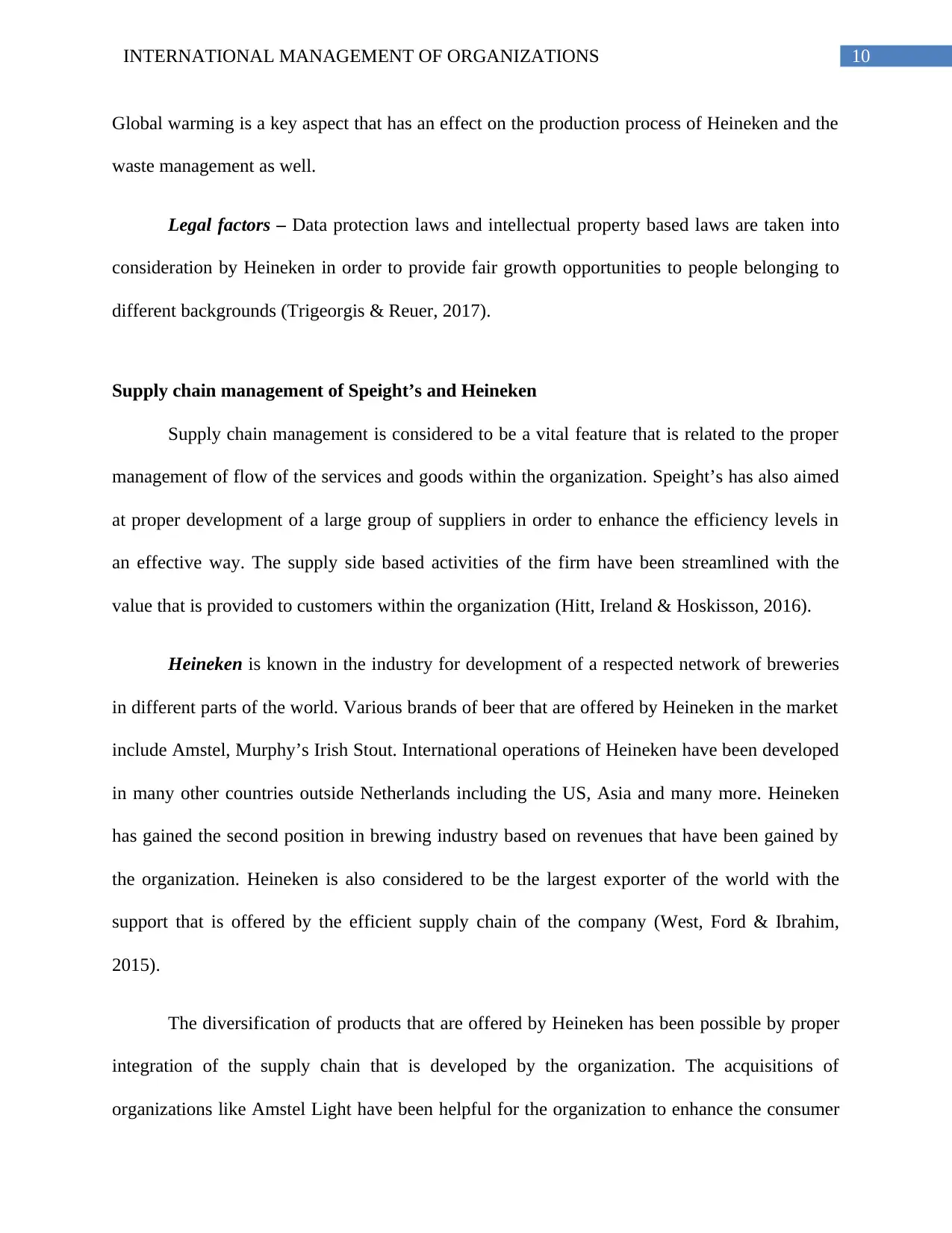
10INTERNATIONAL MANAGEMENT OF ORGANIZATIONS
Global warming is a key aspect that has an effect on the production process of Heineken and the
waste management as well.
Legal factors – Data protection laws and intellectual property based laws are taken into
consideration by Heineken in order to provide fair growth opportunities to people belonging to
different backgrounds (Trigeorgis & Reuer, 2017).
Supply chain management of Speight’s and Heineken
Supply chain management is considered to be a vital feature that is related to the proper
management of flow of the services and goods within the organization. Speight’s has also aimed
at proper development of a large group of suppliers in order to enhance the efficiency levels in
an effective way. The supply side based activities of the firm have been streamlined with the
value that is provided to customers within the organization (Hitt, Ireland & Hoskisson, 2016).
Heineken is known in the industry for development of a respected network of breweries
in different parts of the world. Various brands of beer that are offered by Heineken in the market
include Amstel, Murphy’s Irish Stout. International operations of Heineken have been developed
in many other countries outside Netherlands including the US, Asia and many more. Heineken
has gained the second position in brewing industry based on revenues that have been gained by
the organization. Heineken is also considered to be the largest exporter of the world with the
support that is offered by the efficient supply chain of the company (West, Ford & Ibrahim,
2015).
The diversification of products that are offered by Heineken has been possible by proper
integration of the supply chain that is developed by the organization. The acquisitions of
organizations like Amstel Light have been helpful for the organization to enhance the consumer
Global warming is a key aspect that has an effect on the production process of Heineken and the
waste management as well.
Legal factors – Data protection laws and intellectual property based laws are taken into
consideration by Heineken in order to provide fair growth opportunities to people belonging to
different backgrounds (Trigeorgis & Reuer, 2017).
Supply chain management of Speight’s and Heineken
Supply chain management is considered to be a vital feature that is related to the proper
management of flow of the services and goods within the organization. Speight’s has also aimed
at proper development of a large group of suppliers in order to enhance the efficiency levels in
an effective way. The supply side based activities of the firm have been streamlined with the
value that is provided to customers within the organization (Hitt, Ireland & Hoskisson, 2016).
Heineken is known in the industry for development of a respected network of breweries
in different parts of the world. Various brands of beer that are offered by Heineken in the market
include Amstel, Murphy’s Irish Stout. International operations of Heineken have been developed
in many other countries outside Netherlands including the US, Asia and many more. Heineken
has gained the second position in brewing industry based on revenues that have been gained by
the organization. Heineken is also considered to be the largest exporter of the world with the
support that is offered by the efficient supply chain of the company (West, Ford & Ibrahim,
2015).
The diversification of products that are offered by Heineken has been possible by proper
integration of the supply chain that is developed by the organization. The acquisitions of
organizations like Amstel Light have been helpful for the organization to enhance the consumer
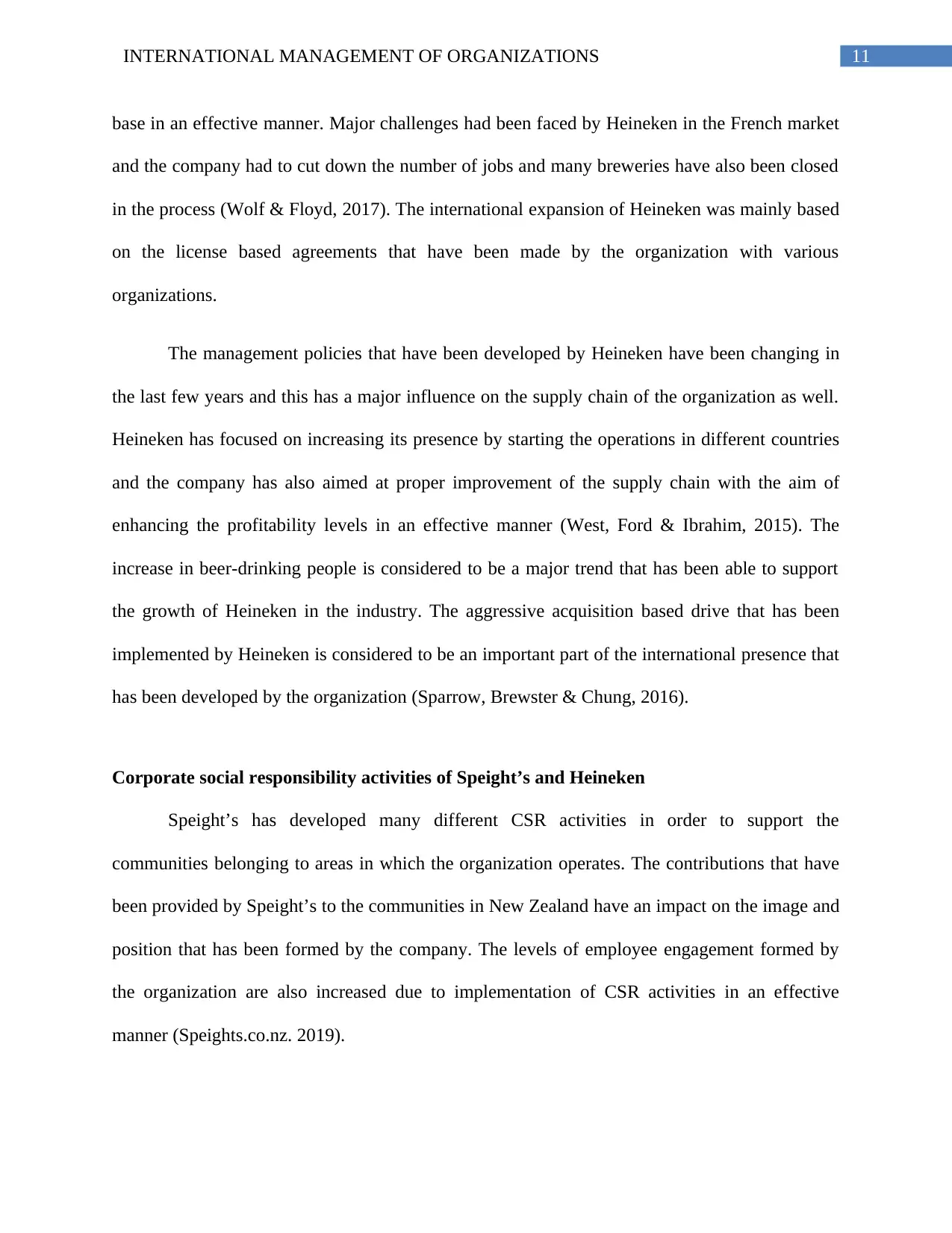
11INTERNATIONAL MANAGEMENT OF ORGANIZATIONS
base in an effective manner. Major challenges had been faced by Heineken in the French market
and the company had to cut down the number of jobs and many breweries have also been closed
in the process (Wolf & Floyd, 2017). The international expansion of Heineken was mainly based
on the license based agreements that have been made by the organization with various
organizations.
The management policies that have been developed by Heineken have been changing in
the last few years and this has a major influence on the supply chain of the organization as well.
Heineken has focused on increasing its presence by starting the operations in different countries
and the company has also aimed at proper improvement of the supply chain with the aim of
enhancing the profitability levels in an effective manner (West, Ford & Ibrahim, 2015). The
increase in beer-drinking people is considered to be a major trend that has been able to support
the growth of Heineken in the industry. The aggressive acquisition based drive that has been
implemented by Heineken is considered to be an important part of the international presence that
has been developed by the organization (Sparrow, Brewster & Chung, 2016).
Corporate social responsibility activities of Speight’s and Heineken
Speight’s has developed many different CSR activities in order to support the
communities belonging to areas in which the organization operates. The contributions that have
been provided by Speight’s to the communities in New Zealand have an impact on the image and
position that has been formed by the company. The levels of employee engagement formed by
the organization are also increased due to implementation of CSR activities in an effective
manner (Speights.co.nz. 2019).
base in an effective manner. Major challenges had been faced by Heineken in the French market
and the company had to cut down the number of jobs and many breweries have also been closed
in the process (Wolf & Floyd, 2017). The international expansion of Heineken was mainly based
on the license based agreements that have been made by the organization with various
organizations.
The management policies that have been developed by Heineken have been changing in
the last few years and this has a major influence on the supply chain of the organization as well.
Heineken has focused on increasing its presence by starting the operations in different countries
and the company has also aimed at proper improvement of the supply chain with the aim of
enhancing the profitability levels in an effective manner (West, Ford & Ibrahim, 2015). The
increase in beer-drinking people is considered to be a major trend that has been able to support
the growth of Heineken in the industry. The aggressive acquisition based drive that has been
implemented by Heineken is considered to be an important part of the international presence that
has been developed by the organization (Sparrow, Brewster & Chung, 2016).
Corporate social responsibility activities of Speight’s and Heineken
Speight’s has developed many different CSR activities in order to support the
communities belonging to areas in which the organization operates. The contributions that have
been provided by Speight’s to the communities in New Zealand have an impact on the image and
position that has been formed by the company. The levels of employee engagement formed by
the organization are also increased due to implementation of CSR activities in an effective
manner (Speights.co.nz. 2019).
⊘ This is a preview!⊘
Do you want full access?
Subscribe today to unlock all pages.

Trusted by 1+ million students worldwide
1 out of 22
Related Documents
Your All-in-One AI-Powered Toolkit for Academic Success.
+13062052269
info@desklib.com
Available 24*7 on WhatsApp / Email
![[object Object]](/_next/static/media/star-bottom.7253800d.svg)
Unlock your academic potential
Copyright © 2020–2025 A2Z Services. All Rights Reserved. Developed and managed by ZUCOL.





